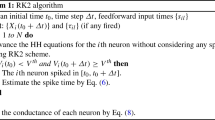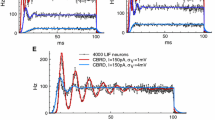Abstract
We present an efficient library-based numerical method for simulating the Hodgkin–Huxley (HH) neuronal networks. The key components in our numerical method involve (i) a pre-computed high resolution data library which contains typical neuronal trajectories (i.e., the time-courses of membrane potential and gating variables) during the interval of an action potential (spike), thus allowing us to avoid resolving the spikes in detail and to use large numerical time steps for evolving the HH neuron equations; (ii) an algorithm of spike-spike corrections within the groups of strongly coupled neurons to account for spike-spike interactions in a single large time step. By using the library method, we can evolve the HH networks using time steps one order of magnitude larger than the typical time steps used for resolving the trajectories without the library, while achieving comparable resolution in statistical quantifications of the network activity, such as average firing rate, interspike interval distribution, power spectra of voltage traces. Moreover, our large time steps using the library method can break the stability requirement of standard methods (such as Runge–Kutta (RK) methods) for the original dynamics. We compare our library-based method with RK methods, and find that our method can capture very well phase-locked, synchronous, and chaotic dynamics of HH neuronal networks. It is important to point out that, in essence, our library-based HH neuron solver can be viewed as a numerical reduction of the HH neuron to an integrate-and-fire (I&F) neuronal representation that does not sacrifice the gating dynamics (as normally done in the analytical reduction to an I&F neuron).















Similar content being viewed by others
References
Aihara, K., & Matsumoto, G. (1986). Chaotic oscillations and bifurcations in squid giant axons. In Chaos, nonlinear science: Theory and applications. Manchester: Manchester University Press.
Cai, D., Rangan, A. V., & McLaughlin, D. W. (2005). Architectural and synaptic mechanisms underlying coherent spontaneous activity in v1. Proceedings of the National Academy of Sciences, USA, 102, 5868–5873.
Campbell, D., & Rose, H. (Eds.) (1983). Order in chaos. Physica D, 7, 1–362.
Dayan, P., & Abbott, L. F. (2001). Theoretical neuroscience: Computational and mathematical modeling of neural systems. Cambridge: MIT Press.
Galan, R. F., Ermentrout, G. B., & Urban, N. N. (2005). Efficient estimation of phase-resetting curves in real neurons and its significance for neural-network modeling. Physical Review Letters, 94, 158101–158104.
Gear, C. W. (1971). Numerical initial value problems in ordinary differential equations. Englewood Cliffs: Prentice Hall.
Guckenheimer, J., & Oliva, R. A. (2002). Chaos in the Hodgkin.Huxley model. SIAM Journal on Applied Dynamical Systems, 1, 105–114.
Hansel, D., Mato, G., Meunier, C., & Neltner, L. (1998). On numerical simulations of integrate-and-fire neural networks. Neural Computation, 10, 467–483.
Hansel, D., & Sompolinsky, H. (1992). Synchronization and computation in a chaotic neural network. Physical Review Letters, 68, 718–721.
Hansel, D., & Sompolinsky, H. (1996). Chaos and synchrony in a model of a hypercolumn in visual cortex. Journal of Computational Neuroscience, 3, 7–34.
Hodgkin, A. L., & Huxley, A. F. (1952). A quantitative description of membrane current and its application to conduction and excitation in nerve. Journal of Physiology, 117, 500–544.
Koch, C. (1999). Biophysics of computation. Oxford: Oxford University Press.
Kosmidis, E. K., & Pakdaman, K. (2003). An analysis of the reliability phenomenon in the FitzHugh-Nagumo model. Journal of Computational Neuroscience, 14, 5–22.
Lin, K. (2006). Entrainment and chaos in a pulse-driven Hodgkin–Huxley oscillator. SIAM Journal on Applied Dynamical Systems, 5, 179–204.
Mainen, Z., & Sejnowski, T. (1995). Reliability of spike timing in neocortical neurons. Science, 268, 1503–1506.
Mattia, M., & Del Giudice, P. (2000). Efficient event-driven simulation of large networks of spiking neurons and dynamical synapses. Neural Computation, 12, 2305–2329.
McLaughlin, D., Shapley, R., Shelley, M., & Wielaard, J. (2000). A neuronal network model of macaque primary visual cortex (V1): Orientation selectivity and dynamics in the input layer 4Cα. Proceedings of the National Academy of Sciences, USA, 97, 8087–8092.
Parker, T. S., & Chua, L. O. (1989). Practical numerical algorithms for chaotic systems. New York: Springer.
Rangan, A. V., & Cai, D. (2007). Fast numerical methods for simulating large-scale integrate-and-fire neuronal networks. Journal of Computational Neuroscience, 22, 81–100.
Rangan, A. V., Cai, D., & McLaughlin, D. W. (2005). Modeling the spatiotemporal cortical activity associated with the line-motion illusion in primary visual cortex. Proceedings of the National Academy of Sciences, USA, 102, 18793–18800.
Reutimann, J., Giugliano, M., & Fusi, S. (2003). Event-based simulation of spiking neurons with stochastic dynamics. Neural Computation, 15, 811–830.
Rinzel, I., & Ermentrout, G. B. (1998). Analysis of neuronal excitability (2nd ed.). In Methods in neuronal modeling: From ions to networks. Cambridge: MIT Press.
Roa, M. A. D., Copelli, M., Kinouchi, O., & Caticha, N. (2007). Scaling law for the transient behavior of type-II neuron models. Physical Review E, 75, 021911.
Rudolph, M., & Destexhe, A. (2007). How much can we trust neural simulation strategies? Neurocomputing, 70, 1966–1969.
Schuster, H. G., & Just, W. (2005). Deterministic chaos. Weinheim: Wiley-VCH.
Shelley, M. J., & Tao, L. (2001). Efficient and accurate time-stepping schemes for integrate-and-fire neuronal networks. Journal of Computational Neuroscience, 11, 111–119.
Somers, D., Nelson, S., & Sur, M. (1995). An emergent model of orientation selectivity in cat visual cortical simple cells. Journal of Neuroscience, 15, 5448–5465.
Troyer, T., Krukowski, A., Priebe, N., & Miller, K. (1998). Contrast invariant orientation tuning in cat visual cortex with feedforward tuning and correlation based intracortical connectivity. Journal of Neuroscience, 18, 5908–5927.
Winfree, A. T. (2001). The geometry of biological time. New York: Springer.
Acknowledgements
The work was supported by NSF grant DMS-0506396 and a grant from the Swartz foundation.
Author information
Authors and Affiliations
Corresponding author
Additional information
Action Editor: David Golomb
Appendix: Parameter values for the Hodgkin–Huxley equations
Appendix: Parameter values for the Hodgkin–Huxley equations
Parameter values or ranges and function definitions of the Hodgkin–Huxley model are as follows (Dayan and Abbott 2001):
Rights and permissions
About this article
Cite this article
Sun, Y., Zhou, D., Rangan, A.V. et al. Library-based numerical reduction of the Hodgkin–Huxley neuron for network simulation. J Comput Neurosci 27, 369–390 (2009). https://doi.org/10.1007/s10827-009-0151-9
Received:
Revised:
Accepted:
Published:
Issue Date:
DOI: https://doi.org/10.1007/s10827-009-0151-9




